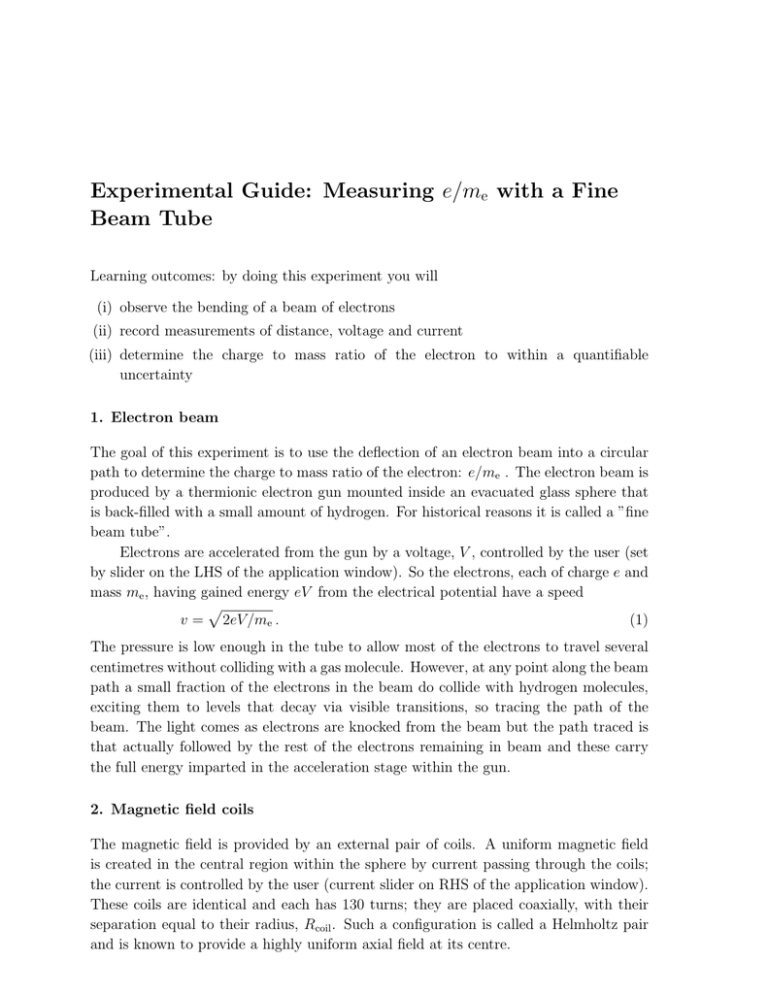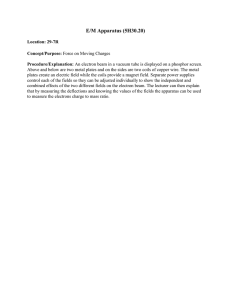Experimental Guide: Measuring e/m e with a Fine Beam Tube
advertisement

Experimental Guide: Measuring e/me with a Fine Beam Tube Learning outcomes: by doing this experiment you will (i) observe the bending of a beam of electrons (ii) record measurements of distance, voltage and current (iii) determine the charge to mass ratio of the electron to within a quantifiable uncertainty 1. Electron beam The goal of this experiment is to use the deflection of an electron beam into a circular path to determine the charge to mass ratio of the electron: e/me . The electron beam is produced by a thermionic electron gun mounted inside an evacuated glass sphere that is back-filled with a small amount of hydrogen. For historical reasons it is called a ”fine beam tube”. Electrons are accelerated from the gun by a voltage, V , controlled by the user (set by slider on the LHS of the application window). So the electrons, each of charge e and mass me , having gained energy eV from the electrical potential have a speed p v = 2eV /me . (1) The pressure is low enough in the tube to allow most of the electrons to travel several centimetres without colliding with a gas molecule. However, at any point along the beam path a small fraction of the electrons in the beam do collide with hydrogen molecules, exciting them to levels that decay via visible transitions, so tracing the path of the beam. The light comes as electrons are knocked from the beam but the path traced is that actually followed by the rest of the electrons remaining in beam and these carry the full energy imparted in the acceleration stage within the gun. 2. Magnetic field coils The magnetic field is provided by an external pair of coils. A uniform magnetic field is created in the central region within the sphere by current passing through the coils; the current is controlled by the user (current slider on RHS of the application window). These coils are identical and each has 130 turns; they are placed coaxially, with their separation equal to their radius, Rcoil . Such a configuration is called a Helmholtz pair and is known to provide a highly uniform axial field at its centre. Experimental Guide: Measuring e/me with a Fine Beam Tube 2 The strength of the field varies with the current i and number of turns N ; within 20mm of the axis and the central point between the coils the density of the magnetic flux, B, is purely axial (to within 0.5%): 3/2 µ0 N i 4 (2) B= 5 Rcoil 3. Beam deflection The electron beam crosses the magnetic field at right angles and this causes the beam to be deflected by a force Fmagnetic that is perpendicular to the motion and the field. The force acts on each electron travelling at speed v, as it moves perpendicular to the field The force is given by Fmagnetic = evB . (3) 4. Circular motion For a particle, or indeed any object, to move along a circular path of radius r with tangential speed v there must be a radially inward force of magnitude Fcircular acting on it: Fcircular = me v 2 /r . (4) So as the magnetic force Fmagnetic remains perpendicular to the motion, it is able to provide the centripetal force for circular motion, Fcircular whence evB = me v 2 /r . (5) 5. determining the charge to mass ratio The above equations can be combined to relate e/me to the three measurable quantities in this experiment: current (i), voltage (V ) and beam diameter (2r). Substituting in Eqn. 5 for the speed in terms of the accelerating voltage from Eqn. 1 and rearranging for e/me 2 V. (6) (e/me ) = (Br)2 Then use Eqn. 2 to obtain 3 2 5 Rcoil V (e/me ) = 2 . 4 µ0 N (ir)2 (7) Experimental Guide: Measuring e/me with a Fine Beam Tube 3 6. Experiment Set the beam energy and coil current so that you obtain a circular beam with a diameter of 40 mm or less. • You can adjust the current i and measure its value to an accuracy of ± 0.005 A. • You can adjust the voltage V and measure its value to an accuracy of ± 0.05 V. • You can measure the radius of a circular beam path to an accuracy of ± 1 mm. Record several different combinations of V, i and r. A simple spreadsheet can be used to store the data and evaluate e/me . Rather than making a spot measurement of e/me based on one set of measurements it is better to use several data sets and to average the results. This is often done by using the measurements to plot a graph that has a gradient related to the quantity that is being determined. Here a plot of (ir)2 against V is useful. 7. Reflection The value of e/me has been determined by similar principles with higher precision achieved by addressing the shortcomings of the Fine Beam Tube. Identify the sources of uncertainty in the methods you used. Propose ways to increase the accuracy of your measurements and propose changes to the apparatus that would lead to increased precision.






